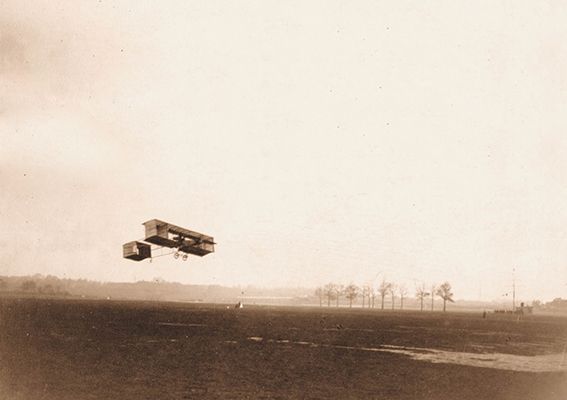
Baron de Caters flies past the grandstand. (coll. Frans Mielants)
A red flag on the tower of the Cathedral:
flying takes place on the 'Wilrijckse Plein'
Despite the very bad weather and the heavy rain, there was still some flying at this first official Belgian flying meeting. However, the audience had to be patient to see one of the pioneers at work. One day it was so bad that Jan Olieslagers was begged to do a few tests against his better judgement. All in all, the organisers had a financial brake even and more meetings were organised in the following years.
To keep the population of Antwerp informed of developments at the airfield, the tower of the cathedral was used as a signal box. A black flag : one is not flying, a red flag : one is flying, a white flag : one will probably fly.
A signal mast had been placed on the site itself, following the example of shipping.
Here the public was informed by means of various flags what was about to happen, who would fly or test run and what prize the daredevil on duty would try to win.
There were also several stands for the public. All in all, this flying week was not a cheap affair. When Prince Albert asks Jan Olieslagers what one needs to become an aviator, he quickly replies: “a lot of courage, a lot of daring and above all a lot of money”, meanwhile looking pityingly at his damaged aircraft.
But in those days there was quite a lot to be earned in prize money, at least if one put in a good performance.
Jan Olieslagers was known in Antwerp and far beyond for his exploits on bicycle and motorcycle.
He made his debut in aviation during this flying week and could count on a lot of support and enthusiasm due to his enormous popularity with the Antwerp population.
Flying weeks were regularly organised on the "Wilrijckse Plein" site afterwards.
It would remain in use as an airfield until 1920 : at that time the expansion of the city made flying here almost impossible.
Photo captions (top-left to bottom-right)
- The aircraft of Pierre Baron de Caters has been restored thanks to the good care of the Bollekens brothers. The Baron makes a successful flight. (coll. Dirk Buytaert)
- Count de la Vaulx keeps a close eye on the filling of his gas balloon. In the background the gas cylinders ready for use. (coll. Dirk Buytaert)
- Wilford's Wright aircraft is being prepared for flight. It is placed on the launch rail. In the back on the left the construction in which the counterweight was hung. This served to give the aircraft momentum at launch. (coll. Dirk Buytaert)
- The launch was successful and Wilford makes a short flight, much to the delight of the spectators who are rewarded for their patience. (coll. Dirk Buytaert)
- When the envelope is completely filled, the engineers bring out the balloon. The people cheer: there will be flying. (coll. Dirk Buytaert)
- View of the signal mast in the middle of the site. Flags were used to indicate who flew or would fly. The tower of the cathedral (then the highest point of the city and visible from afar) was also used as a signal box : a red flag: one is flying. (coll. Dirk Buytaert)
- The site of the Genie on the Wilrijckse Plein near the 'de Dikke Mee' pub. (coll. Dirk Buytaert)
- Jan Olieslagers 'den Antwerpschen Duivel' proudly posing with his Blériot. (coll. Frans Mielants)






